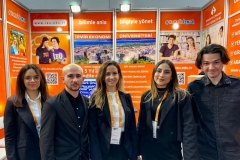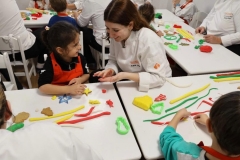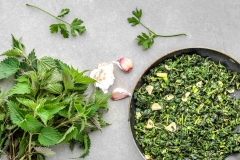
SCHOOL OF APPLIED MANAGEMENT SCIENCES
Gastronomy and Culinary Arts Program
CLM 400 | Course Introduction and Application Information
| Course Name |
Oenology
|
|
Code
|
Semester
|
Theory
(hour/week) |
Application/Lab
(hour/week) |
Local Credits
|
ECTS
|
|
CLM 400
|
Fall/Spring
|
3
|
0
|
3
|
5
|
| Prerequisites |
None
|
|||||
| Course Language |
English
|
|||||
| Course Type |
Service Course
|
|||||
| Course Level |
First Cycle
|
|||||
| Mode of Delivery | - | |||||
| Teaching Methods and Techniques of the Course | - | |||||
| Course Coordinator | - | |||||
| Course Lecturer(s) | ||||||
| Assistant(s) | - | |||||
| Course Objectives | Main focus of this course is to understand how to taste wine and to develop tasting techniques and finally to combine them with food. The course will also provide depth knowledge on winemaking and viticulture, main wine regions in Europe, wine culture and service techniques. Field trip will be organized in order to have a visual understanding. |
| Learning Outcomes |
The students who succeeded in this course;
|
| Course Description | This course covers winemaking and viticulture, wine tasting and evaluating, learning about wine regions and combining all these with gastronomy. |
|
|
Core Courses | |
| Major Area Courses |
X
|
|
| Supportive Courses | ||
| Media and Management Skills Courses | ||
| Transferable Skill Courses |
WEEKLY SUBJECTS AND RELATED PREPARATION STUDIES
| Week | Subjects | Related Preparation |
| 1 | Introduction to the course | |
| 2 | Introduction to fermented grape juice from historical, scientific, economical, and gastronomical point of view viticulture | Clark Smith, Postmodern winemaking: rethinking the modern science of an ancient craft, Berkeley: University of California Press, 2013 |
| 3 | Introduction of fermentation and fermented grape juice making | Bryce Rankine, Making Good Wine: A Manual of Winemaking Practice for Australia and New Zealand, Chap 6, Sun Books, 1989 Ribéreau-Gayon Pascal, Dubourdieu, Donèche Bernard, Handbook of enology, Chap 1, 2nd edn, John Wiley, 2006 |
| 4 | Elaborate Red / White / Rose fermented grape juice making techniques and differences. Understanding their effect on fermented grape juices | Bryce Rankine, Making Good Wine: A Manual of Winemaking Practice for Australia and New Zealand, Chap 4, Sun Books, 1989 “Ribéreau-Gayon Pascal, Dubourdieu, Donèche Bernard, Handbook of enology, Chap 12-13, 2nd edn, John Wiley, 2006. |
| 5 | Midtern | |
| 6 | Field Trip | |
| 7 | Introduction to the tasting of fermented grape juice and grape varieties | Bryce Rankine, Making Good Wine: A Manual of Winemaking Practice for Australia and New Zealand, Chap 18, Sun Books, 1989 |
| 8 | Appellations in the world and major grape varieties | Hugh Johnson, Jancis Robinson, World Wine Atlas, Octopus Publishing,2019 |
| 9 | Presentations about grape varieties and appellations | |
| 10 | Barrel management in fermented grape juice making | Bryce Rankine, Making Good Wine: A Manual of Winemaking Practice for Australia and New Zealand, Chap 13, Sun Books, 1989 Ribéreau-Gayon Pascal, Dubourdieu, Donèche Bernard, Handbook of enology, pg 58-68, 2nd edn, John Wiley, 2006 |
| 11 | Fermented grape juice and food pairing principles | Robert J. Harrington, Food and Wine Pairing, A Sensory Experience, (John Wiley and Sons, 2008) Architectural Elements in the Wine and Food Pairing Process (149 - 159) |
| 12 | Fundamental fermented grape juice faults | Bryce Rankine, Making Good Wine: A Manual of Winemaking Practice for Australia and New Zealand, Chap 19, Sun Books, 1989 Ribéreau-Gayon Pascal, Dubourdieu, Donèche Bernard, Handbook of enology, chap 7, 2nd edn, John Wiley, 2006 |
| 13 | Champagne / Prosecco / Cava techniques | Bryce Rankine, Making Good Wine: A Manual of Winemaking Practice for Australia and New Zealand, Chap 4, Sun Books, 1989 Ribéreau-Gayon Pascal, Dubourdieu, Donèche Bernard, Handbook of enology, chap 12, 2nd edn, John Wiley, 2006 |
| 14 | Different fermented grape juice making styles | Bryce Rankine, Making Good Wine: A Manual of Winemaking Practice for Australia and New Zealand, Chap 4, Sun Books, 1989 Ribéreau-Gayon Pascal, Dubourdieu, Donèche Bernard, Handbook of enology, chap 14, 2nd edn, John Wiley, 2006. |
| 15 | Semester review | |
| 16 | Final Exam |
| Course Notes/Textbooks | Handbook of Enology Vol1 and Vol2”: Pascal Ribereau-Gayon, Denis Dubourdieu, Bernard Doneche, Aline Lonvaud: 2nd edition ISBN-13; 978-0-470-02034-1 ISBN-10; 0-470-01034-7 “Making Good Wine ; A Manual of Winemaking Practice for Australia and New Zealand” :Bryce Rankine ISBN ; 0-7251-0563-1 “World Wine Atlas” : Hugh Johnson, Jancis Robinson ISBN 987-975-10-4216-3 “Postmodern Winemaking” : Clark Smith ISBN 978-0-520-27519-5 |
| Suggested Readings/Materials | https://www.awri.com.au/information_services/information-packs/ |
EVALUATION SYSTEM
| Semester Activities | Number | Weigthing |
| Participation | ||
| Laboratory / Application | ||
| Field Work | ||
| Quizzes / Studio Critiques | ||
| Portfolio | ||
| Homework / Assignments | ||
| Presentation / Jury |
1
|
20
|
| Project | ||
| Seminar / Workshop | ||
| Oral Exams | ||
| Midterm |
1
|
30
|
| Final Exam |
1
|
50
|
| Total |
| Weighting of Semester Activities on the Final Grade |
2
|
50
|
| Weighting of End-of-Semester Activities on the Final Grade |
1
|
50
|
| Total |
ECTS / WORKLOAD TABLE
| Semester Activities | Number | Duration (Hours) | Workload |
|---|---|---|---|
| Theoretical Course Hours (Including exam week: 16 x total hours) |
16
|
3
|
48
|
| Laboratory / Application Hours (Including exam week: '.16.' x total hours) |
16
|
0
|
|
| Study Hours Out of Class |
14
|
3
|
42
|
| Field Work |
0
|
||
| Quizzes / Studio Critiques |
0
|
||
| Portfolio |
0
|
||
| Homework / Assignments |
0
|
||
| Presentation / Jury |
1
|
15
|
15
|
| Project |
0
|
||
| Seminar / Workshop |
0
|
||
| Oral Exam |
0
|
||
| Midterms |
1
|
20
|
20
|
| Final Exam |
1
|
25
|
25
|
| Total |
150
|
COURSE LEARNING OUTCOMES AND PROGRAM QUALIFICATIONS RELATIONSHIP
|
#
|
Program Competencies/Outcomes |
* Contribution Level
|
||||
|
1
|
2
|
3
|
4
|
5
|
||
| 1 | Successfully applies theoretical and practical knowledge and skills in Gastronomy and Culinary Arts |
X | ||||
| 2 | Carries best practices in terms of work and food security, safety and hygiene in food production |
X | ||||
| 3 | Appreciates, evaluates and makes decisions regarding to visual, textual and nutritional data with respect to food production and presentation |
|||||
| 4 | Recognizes and evaluates the impact of gastronomy on culture and society |
X | ||||
| 5 | Assumes responsibility for solving complex problems that may occur in the field of Gastronomy and Culinary Arts, both individually and as a team member |
X | ||||
| 6 | Evaluates the knowledge and skills acquired in the field of Gastronomy and Culinary Arts with a critical approach and effectively communicate their ideas and suggestions for solutions in written and oral form. |
X | ||||
| 7 | Possesses necessary knowledge and skills in relevant fields such as gastronomy, design, law and management and effectively apply them to the practice of Culinary Arts |
|||||
| 8 | Uses the technological tools related to Gastronomy and Culinary Arts effectively |
|||||
| 9 | Updates and improve the knowledge, skills and competencies related to Gastronomy and Culinary Arts with lifelong learning awareness and sustainability with an ethical approach |
|||||
| 10 | Collects data in the areas of Gastronomy and Culinary Arts and communicate with colleagues in a foreign language. (European Language Portfolio Global Scale”, Level B1) |
|||||
| 11 | Speaks a second foreign at a medium level of fluency efficiently |
|||||
| 12 | Relates the knowledge gained through the history of humanity to the field of expertise |
X | ||||
*1 Lowest, 2 Low, 3 Average, 4 High, 5 Highest
NEWS |ALL NEWS

Aegean flavors from the chefs of the future
Izmir University of Economics (IUE) Department of Gastronomy and Culinary Arts left its mark on the 6th Izmir GastroFest, organized this year with
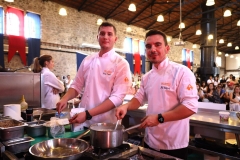
They added flavor to GURMEFEST
GURMEFEST, one of the biggest food, drink and entertainment festivals of Izmir, was ‘flavored’ with the dishes prepared and presented by the
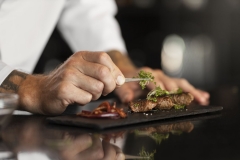
“Izmir and Bodrum will class up”
The MICHELIN Guide, one of the most prestigious restaurant rating systems in the world, has added Izmir and Bodrum to its Turkish
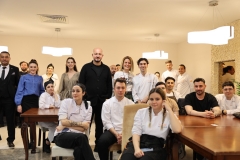
IUE graduates will prepare the flavors unique to Turkish cuisine
Bilsev Group, who is preparing to expand to Dubai this year with its Ferdi Baba, Fabrice Restaurant and Baba Pizza brands, will
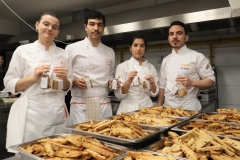
They prepared products that are filling and have a long shelf life
25 students of Department of Gastronomy and Culinary Arts of Izmir University of Economics (IUE) prepared products with a long shelf life,



